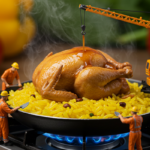In today’s digital age, artificial intelligence tools are revolutionizing the way we generate content, especially for visual art, storytelling, and design. One such tool is AI-based image generation, where users input specific prompts to create highly detailed and imaginative visuals. The key to getting the best results from these tools lies in crafting clear and effective prompts.
In this article, we’ll dive into the process of collecting and refining prompts, as demonstrated through a surreal and dramatic scenario involving a giant doll-like girl, to help you unlock the creative potential of AI.
What is a Prompt Collection?
Prompt collection is the process of gathering specific, detailed descriptions and ideas that can be used to generate content via AI tools. Whether you’re looking to create an image, generate text, or brainstorm new concepts, prompts are the essential building blocks. They can range from simple descriptions to elaborate narratives that guide the AI’s creation process.
The Importance of Detailed Prompts
Detailed prompts ensure the AI has enough context to generate high-quality, accurate content. Think of a prompt as a recipe—each ingredient you include shapes the final output. A good prompt provides essential information, such as setting, character design, mood, and action, without leaving too much room for ambiguity.
Example of a Detailed Prompt:
Result:

Let’s look at a detailed prompt for generating a dramatic scene:
A dramatic and surreal view from inside an airplane, showing a passenger staring in shock through the window at a massive, eerie giant doll-like girl walking close to the aircraft. She has a porcelain face, large glassy eyes, and wears a yellow blouse with an orange dress. Her oversized body looms over the cars below, which are swerving in panic. Each of her slow, mechanical steps shakes the ground and leaves cracked pavement behind. The passenger's reflection is visible in the window, emphasizing their fear and disbelief. The airplane wing and cabin interior are partially visible, adding realism to the scene. The landscape below consists of rolling fields and small villages, dwarfed by the colossal girl. The sky is filled with dark clouds, creating an intense and cinematic atmosphere. The giant doll-like girl is far taller than the airplane, easily surpassing its height, making the plane look small in comparison.You can generate images based on detailed prompts like the one above for free using ImageFx. And you can also generate video sequences from your prompts using hailuoai.video.
Tiny Workers
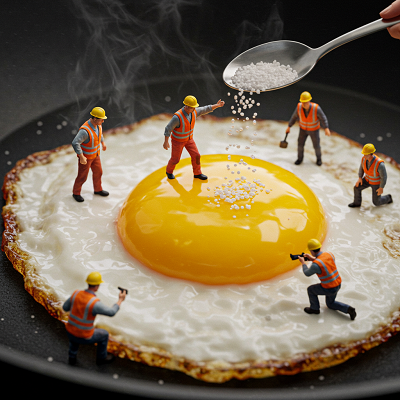
A hyper-realistic close-up of a fried egg with a golden yolk and crispy, browned edges sizzling in a black frying pan. Surrounding the egg are miniature construction workers in orange safety vests and hard hats, actively working as if the egg is a construction project. One worker is walking across the egg white, another is carefully pouring coarse salt from a tiny spoon in slow motion, while a third is kneeling and inspecting the yolk with a magnifying glass. The egg slightly sizzles as steam rises, and the workers move naturally, adjusting their positions. The scene is playful, surreal, and macro-photography styled, with warm lighting and subtle camera movements to enhance realism.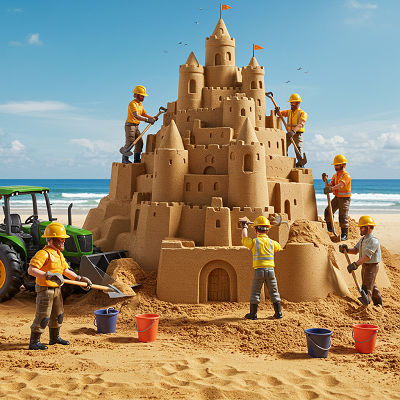
A hyper-realistic image of six male construction workers building a massive and towering sandcastle near the beach. The workers are real humans, not toys or dolls, dressed in construction gear such as helmets, gloves, and boots. They are actively working with realistic body movements, using proper construction tools like shovels, trowels, and buckets to shape intricate details of the sandcastle. A tractor is present, assisting in moving large amounts of sand. The background features a stunning beach view with blue skies, ocean waves, and soft golden sand. The lighting is natural, capturing the warmth of the sun and subtle shadows on the sandcastle, making the scene look immersive and lifelike.
This prompt guides the AI to create a specific scene that includes character design, atmosphere, perspective, and scale.
Breaking Down the Elements of a Great Prompt
To create compelling prompts like the one above, you need to focus on the following elements:
Perspective: Consider the viewpoint from which the scene is observed. In our example, the perspective is from inside the airplane, with the passenger looking out the window, which helps ground the viewer in the scene.
Setting and Environment: Describe where the action takes place. Is it indoors or outdoors? What is the weather like? What’s the general atmosphere? In the example above, we have a surreal landscape filled with rolling fields and dark clouds, which set the tone for the scene.
Character Description: If your prompt involves characters, give details about their appearance, clothing, expressions, and actions. In our case, the giant doll-like girl is described in great detail—her porcelain face, glassy eyes, and mechanical steps.
Action: What’s happening in the scene? What are the characters doing? In the example, the doll-like girl is walking slowly, causing the ground to shake with each step, and cars below are swerving in panic.
Mood and Tone: Convey the emotional atmosphere of the scene. Is it eerie, whimsical, dramatic, or peaceful? The dark clouds and cinematic atmosphere in our prompt suggest an intense, unsettling mood.
Using Prompts for Creative Image Generation
Once you have your detailed prompts, you can use AI tools like DALL·E or MidJourney to generate images. Here’s how to take full advantage of these tools:
- Be Specific: Include as many details as necessary to guide the AI.
- Experiment: Don’t be afraid to try different variations or play with the descriptions to see how the AI interprets them.
- Refine: After generating an image, you may need to refine the prompt to improve the result. Adding or removing details can significantly change the outcome.
How to Apply Prompt Collection in Your Projects
Incorporating prompt collection into your creative projects can open up new possibilities. Whether you’re working on visual art, writing, or design, you can use the following steps:
- Collect Ideas: Start by brainstorming a list of creative concepts.
- Refine the Details: Flesh out your ideas into detailed prompts.
- Generate: Use your prompts to create content using AI tools.
- Edit and Revise: After generating the content, make any necessary adjustments to improve it.
Video tutorial:
Related Articles:
- Prompt Free 100%: Peach Fruit Revolution: The Blooming Beginning of Nature’s Harvest
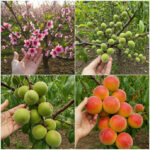
- Free 100% – Miniature construction workers prompt collections

- Animal Companions of Worldwide Countries – Prompt Free 100%
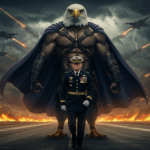
- Prompt free 100%: Apple Revolution: The Blooming Beginning of Nature’s Harvest
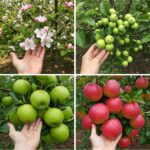
- Prompt free 100%: Animal Collection Prompts
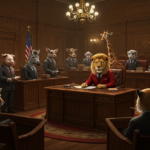
- Tiny Workers Prompts To Generate The Images – Free 100%
